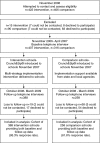Effectiveness of a multi-strategy intervention in increasing the implementation of vegetable and fruit breaks by Australian primary schools: a non-randomized controlled trial
- PMID: 22889085
- PMCID: PMC3490882
- DOI: 10.1186/1471-2458-12-651
Effectiveness of a multi-strategy intervention in increasing the implementation of vegetable and fruit breaks by Australian primary schools: a non-randomized controlled trial
Abstract
Background: Limited evidence exists describing the effectiveness of strategies in facilitating the implementation of vegetable and fruit programs by schools on a population wide basis. The aim of this study was to examine the effectiveness of a multi-strategy intervention in increasing the population-wide implementation of vegetable and fruit breaks by primary schools and to determine if intervention effectiveness varied by school characteristics.
Methods: A quasi-experimental study was conducted in primary schools in the state of New South Wales, Australia. All primary schools in one region of the state (n = 422) received a multi-strategy intervention. A random sample of schools (n = 406) in the remainder of the state served as comparison schools. The multi-strategy intervention to increase vegetable and fruit breaks involved the development and provision of: program consensus and leadership; staff training; program materials; incentives; follow-up support; and implementation feedback. Comparison schools had access to routine information-based Government support. Data to assess the prevalence of vegetable and fruit breaks were collected by telephone from Principals of the intervention and comparison schools at baseline (2006-2007) and 11 to 15 months following the commencement of the intervention (2009-2010). GEE analysis was used to examine the change in the prevalence of vegetable and fruit breaks in intervention schools compared to comparison schools.
Results: At follow-up, prevalence of vegetable and fruit breaks increased significantly in both intervention (50.3% to 82.0%, p < 0.001) and comparison (45.4% to 60.9% p < 0.001) schools. The increase in prevalence in intervention schools was significantly larger than among comparison schools (OR 2.36; 95% CI 1.60-3.49, p <0.001). The effect size was similar between schools regardless of the rurality or socioeconomic status of school location, school size or government or non-government school type.
Conclusion: The findings suggest that a multi-strategy intervention can significantly increase the implementation of vegetable and fruit breaks by a large number of Australian primary schools.
References
-
- National Health AG, Medical Research C, editor. National Health and Medical Research Council, A.G. Dietary Guidelines for Children and Adolescents in Australia incorporating the Infant Feeding Guidelines for Health Workers. Australian Government Publishing, Canberra; 2003.
-
- Tohill BC. Dietary intake of fruit and vegetables and management of body weight. Background paper for the Joint FAO/WHO Workshop on Fruit and Vegetables for Health, 1–3 September 2004, Kobe, Japan. Centers for Disease Control and Prevention, Atlanta; 2005.
Publication types
MeSH terms
LinkOut - more resources
Full Text Sources


